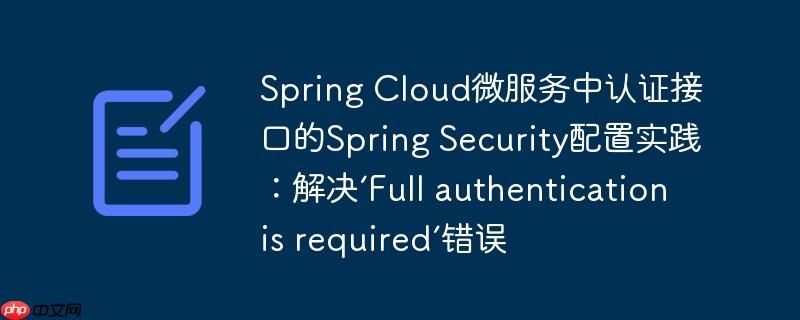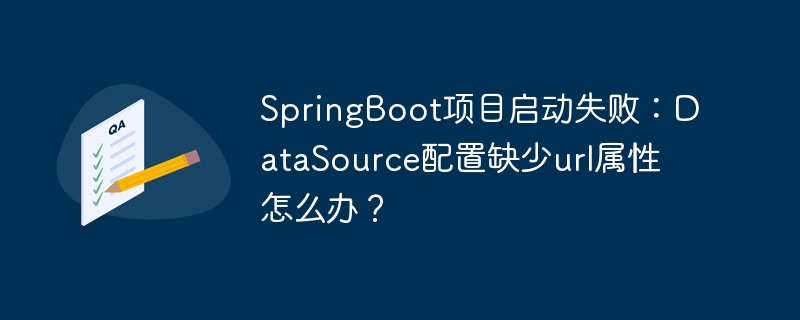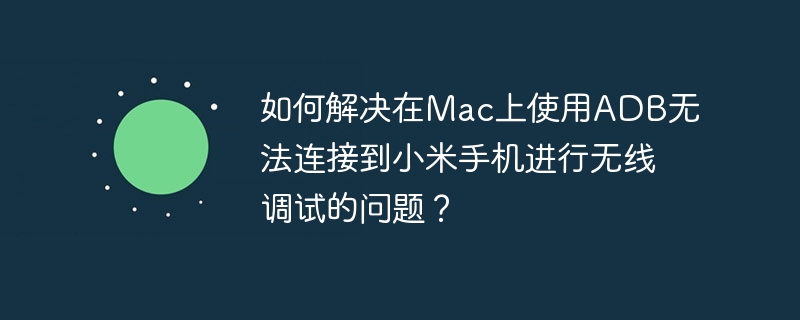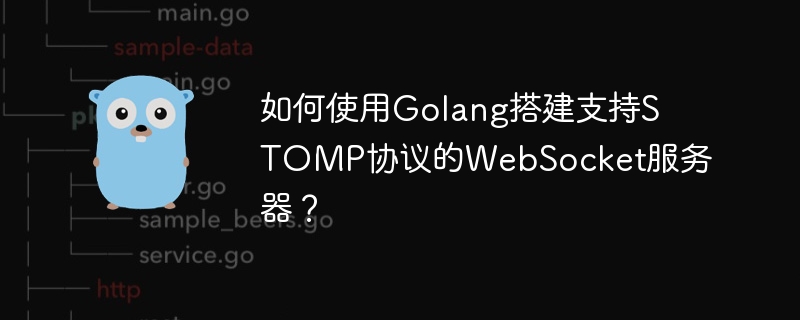
在spring Cloud微服務架構中,當認證服務(Auth Service)的注冊、登錄等公共接口被spring security默認保護時,會導致“Full authentication is required”錯誤。本文旨在提供詳細的Spring Security配置指南,通過正確使用permitAll()方法允許匿名訪問這些關鍵接口,并探討在API網(wǎng)關集成場景下的問題排查,同時引入Spring Security的現(xiàn)代配置方式,確保服務正常運行和安全性。
1. 問題背景與錯誤分析
在構建基于spring cloud的微服務應用時,認證服務通常會提供用戶注冊(/authenticate/signup)、登錄(/authenticate/login)和刷新令牌(/authenticate/refreshtoken)等接口。這些接口的特點是它們在用戶尚未認證時就需要被訪問。然而,spring security的默認配置是高度安全的,它會假定所有請求都需要進行身份驗證。當這些公共接口沒有被明確排除在安全鏈之外時,spring security就會拋出full authentication is required to access this Resource錯誤。
當請求通過API gateway轉發(fā)時,如果認證服務本身拒絕了請求,API Gateway可能會返回Could not send request之類的通用錯誤,這通常是上游服務(認證服務)返回了非預期的響應(如401 Unauthorized)導致的,而非API Gateway本身的路由或連接問題。因此,解決核心問題在于正確配置認證服務的Spring Security。
2. Spring Security核心配置:允許匿名訪問
解決此問題的關鍵在于告訴Spring Security,特定的認證接口不需要任何形式的身份驗證即可訪問。這通過在安全配置中為這些路徑設置permitAll()規(guī)則來實現(xiàn)。
2.1 傳統(tǒng)配置方式(基于WebSecurityConfigurerAdapter)
在Spring Security的早期版本中,通常通過繼承WebSecurityConfigurerAdapter并重寫configure(httpSecurity http)方法來定義安全規(guī)則。以下是針對認證接口的配置示例:
import org.springframework.context.annotation.Configuration; import org.springframework.security.config.annotation.web.builders.HttpSecurity; import org.springframework.security.config.annotation.web.configuration.EnableWebSecurity; import org.springframework.security.config.annotation.web.configuration.WebSecurityConfigurerAdapter; @Configuration @EnableWebSecurity public class SecurityConfig extends WebSecurityConfigurerAdapter { @Override protected void configure(HttpSecurity http) throws Exception { http .csrf().disable() // 禁用CSRF,通常用于無狀態(tài)的REST API .authorizeRequests(auth -> { // 允許匿名訪問認證相關的接口 auth.antMatchers("/authenticate/signup", "/authenticate/login", "/authenticate/refreshtoken").permitAll(); // 其他所有請求都需要認證 auth.anyRequest().authenticated(); }); // 如果需要,可以添加會話管理、異常處理等 // .sessionManagement().sessionCreationPolicy(SessionCreationPolicy.STATELESS); // .exceptionHandling().authenticationEntryPoint(jwtAuthenticationEntryPoint); } }
代碼解析:
- http.csrf().disable(): 對于無狀態(tài)的restful API,通常會禁用CSRF保護,因為它主要用于基于會話的Web應用。
- authorizeRequests(auth -> { … }): 這是配置授權規(guī)則的入口。
- auth.antMatchers(“/authenticate/signup”, “/authenticate/login”, “/authenticate/refreshtoken”).permitAll(): 這是核心所在。它指定了/authenticate/signup、/authenticate/login和/authenticate/refreshtoken這三個路徑可以被所有用戶(包括未認證用戶)訪問。
- auth.anyRequest().authenticated(): 這是一個兜底規(guī)則,意味著除了前面permitAll()指定的路徑外,所有其他請求都必須經(jīng)過身份驗證。
注意事項: 規(guī)則的順序非常重要。更具體的規(guī)則(如permitAll())應該放在更寬泛的規(guī)則(如anyRequest().authenticated())之前。如果anyRequest().authenticated()放在前面,它會優(yōu)先匹配所有請求,導致permitAll()規(guī)則失效。
2.2 現(xiàn)代配置方式(基于SecurityFilterChain Bean)
自Spring Security 5.7.0-M2版本起,WebSecurityConfigurerAdapter被標記為廢棄,推薦使用SecurityFilterChain作為Bean來配置安全。這種方式更加靈活和模塊化。
import org.springframework.context.annotation.Bean; import org.springframework.context.annotation.Configuration; import org.springframework.security.config.annotation.web.builders.HttpSecurity; import org.springframework.security.config.annotation.web.configuration.EnableWebSecurity; import org.springframework.security.web.SecurityFilterChain; @Configuration @EnableWebSecurity public class SecurityConfig { @Bean public SecurityFilterChain filterChain(HttpSecurity http) throws Exception { http .csrf(csrf -> csrf.disable()) // 禁用CSRF .authorizeHttpRequests(auth -> auth // 允許匿名訪問認證相關的接口 .requestMatchers("/authenticate/signup", "/authenticate/login", "/authenticate/refreshtoken").permitAll() // 其他所有請求都需要認證 .anyRequest().authenticated() ); // 如果需要,可以添加其他配置 // .sessionManagement(session -> session.sessionCreationPolicy(SessionCreationPolicy.STATELESS)); // .exceptionHandling(exceptions -> exceptions.authenticationEntryPoint(jwtAuthenticationEntryPoint)); return http.build(); } }
代碼解析與優(yōu)勢:
- @Bean public SecurityFilterChain filterChain(HttpSecurity http): 通過定義一個返回SecurityFilterChain的Bean來配置安全鏈。
- csrf(csrf -> csrf.disable()): 新的Lambda表達式風格,更簡潔。
- authorizeHttpRequests(auth -> auth …): 替代了舊的authorizeRequests(),推薦使用。
- requestMatchers(“/authenticate/signup”, …).permitAll(): 功能與antMatchers類似,但推薦使用requestMatchers,它支持更多匹配策略。
- http.build(): 構建并返回SecurityFilterChain實例。
這種方式更符合spring boot的習慣,并且提供了更好的可讀性和可測試性。強烈建議采用此現(xiàn)代配置方式。
3. API Gateway集成與問題排查
當認證服務配置正確后,API Gateway通常能夠順利轉發(fā)請求并獲得正確的響應。如果仍然遇到Could not send request或類似錯誤,請檢查以下幾點:
- 網(wǎng)絡連通性: 確保API Gateway能夠訪問到認證服務的地址和端口。
- 路由配置: 檢查API Gateway的路由規(guī)則是否正確地將請求轉發(fā)到認證服務的正確路徑。例如:
spring: cloud: gateway: routes: - id: auth_service uri: lb://AUTH-SERVICE # 假設認證服務的服務名為AUTH-SERVICE predicates: - Path=/authenticate/** # 匹配所有以/authenticate開頭的路徑
- 日志分析:
- 認證服務日志: 檢查認證服務的控制臺或日志文件,確認是否還有Spring Security相關的錯誤(如401 Unauthorized)。如果錯誤消失,說明核心問題已解決。
- API Gateway日志: 查看API Gateway的日志,了解它在轉發(fā)請求時是否遇到連接超時、目標服務不可達或響應解析錯誤等問題。
- CORS配置: 如果前端應用與API Gateway或認證服務不在同一域,需要正確配置CORS(跨域資源共享)。雖然“Full authentication is required”不是CORS錯誤,但CORS配置不當可能導致其他請求失敗。
4. 總結
在Spring Cloud微服務架構中,正確配置Spring Security以允許匿名訪問認證接口(如注冊、登錄、刷新令牌)至關重要。通過在SecurityFilterChain(或舊版中的WebSecurityConfigurerAdapter)中明確使用permitAll()方法,可以有效解決Full authentication is required to Access this resource錯誤。同時,在API Gateway場景下,確保認證服務本身配置無誤是解決上游錯誤的關鍵。采用Spring Security的現(xiàn)代配置方式,不僅能解決當前問題,也使得安全配置更具可維護性和前瞻性。



















